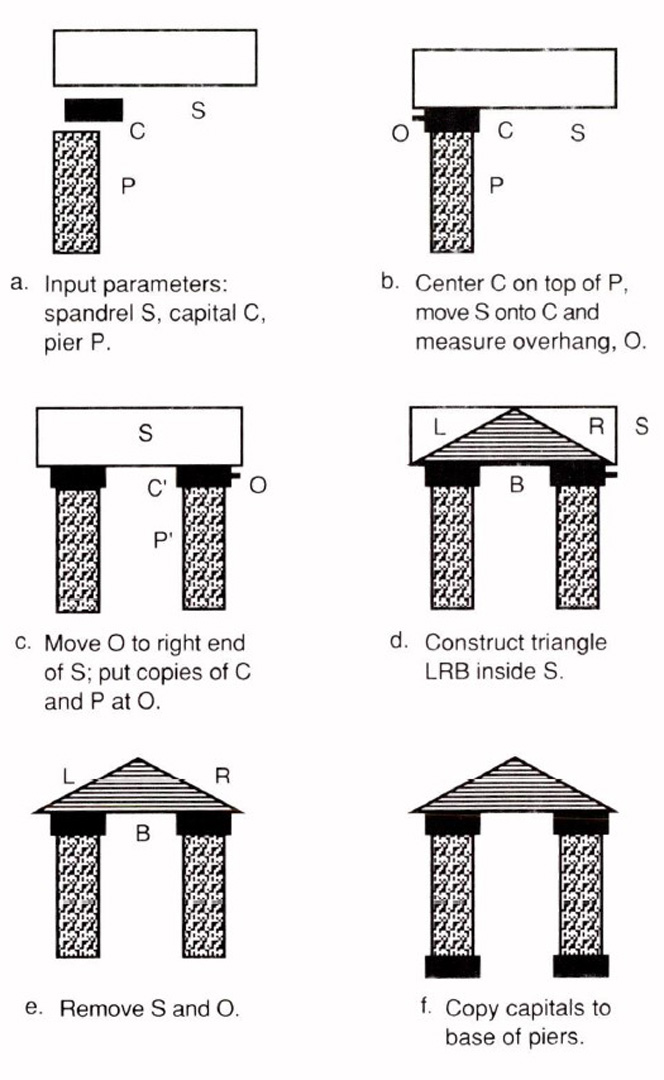“Metamouse: specifying graphical procedures by example” by Maulsby, Witten and Kittlitz
Conference:
Type(s):
Title:
- Metamouse: specifying graphical procedures by example
Presenter(s)/Author(s):
Abstract:
Metamouse is a device enabling the user of a drawing program to specify graphical procedures by supplying example execution traces. The user manipulates objects directly on the screen, creating graphical tools where necessary to help make constraints explicit; the system records the sequence of actions and induces a procedure. Generalization is used both to identify the key features of individual program steps, disregarding coincidental events; and to connect the steps into a program graph, creating loops and conditional branches as appropriate. Metamouse operates within a 2D click-and-drag drafting package, and incorporates a strong model of the relative importance of different types of graphical constraint. Close attention is paid to user interface aspects, and Metamouse helps the user by predicting and performing actions, thus reducing the tedium of repetitive graphical editing tasks.
References:
1. Abbott, Edwin A. Flatland m A Romance of Many Dimensions. Signet Classics edition. New York. 1984.
2. Andreae, Peter. “Justified generalization: acquiring procedures from examples.'” PhD thesis. Department of Electrical Engineering and Computer Science, MIT. January 1985.
3. Angluin, Dana and Smith, C. H. “Inductive inference: theory and methods.” Computing Surveys 3 (15), pp. 237-269. September 1983.
4. Bier, Eric A. and Stone, Maureen C. “Snap-dragging.” Proc. ACM SIGGRAPH ’86 (Dallas, August 18-22, 1986), in Computer Graphics 20, 4, pp. 233-240.
5. Borning, Alan. “Defining constraints graphically.” Human Factors in Computing Systems: Proc. ACM SIGCH1 ’86. Boston. April 1986.
6. Dennett, Daniel C. The intentional Stance. MIT Press. Cambridge MA. 1987.
7. Fuller, Norma and Prusinkiewicz, P. “L.E.G.O.–an interactive graphics system for teaching geometry and computer graphics.” Proc. CIPS Edmonton 1986.
8. Fuller, Norma and Prusinkiewicz, P. “Geometric modeling with Euclidean constructions,” in {231, pp. 379-391.
9. Halbert, Dan. “Programming by example.” Research Report OSD-T8402. Xerox PARC. Palo Alto CA. December 1984,
10. Kurlander, David and Bier, Eric A. “Graphical search and replace.” Proc. ACM SIGGRAPH ’88 (Atlanta GA, August 1-5, 1988), in Computer Graphics 22, 4, pp. 113-120.
11. MacDonald, Bruce A. and Witten, Ion H. “Programming computer controlled systems by non-experts.'” Proc. IEEE Systems, Man and Cybernetics Annual Conference. Alexandria VA. October 1987.
12. Cutter, Mark, Halpem, B., Spiegel, J. MacDraw. Apple Computer Inc. 1985, 1987.
13. Maulsby, David. “Inducing procedures interactively.” MSc thesis. Department of Computer Science, University of Calgary. December 1988.
14. Maulsby, David and Witten, Ian H. “Inducing procedures in a direct-manipulation environment.” Proc. ACM SIGCHI ’89 (in press).
15. Maulsby, David, Kittlitz, Ken and Witten, Ian H. “Constraint-solving in interactive graphicsma user-friendly approach.” Proc. Computer Graphics International 1989 (in press).
16. Myers, Brad. Creating User Interfaces by Demonstration. Academic Press. San Diego. 1988.
17. Noma, T., Kunii, T. L., Kin, N., Enomoto, H., Aso, E. and Yamamoto, T. Y. “Drawing input through geometrical constructions: specification and applications,” in {23}, pp. 403-415.
18. Papert, Seymour. Mindstorms. Basic Books. New York. 1980.
19. Preparata, Franco P. and Shamos, Michael I. Computational Geometry. Springer-Verlag. New York. 1985.
20. Rich, Charles and Waters, Richard. “‘The programmer’s apprentice: a research overview.” IEEE Computer 21 (11), pp. 11-25. November 1988.
21. Smith, David C. “Pygmalion: a creative programming environment.” Report STAN-CS-75-499. Stanford U. 1975.
22. Sutherland, Ivan E. “Sketchpad: a man-machine graphical communication system.” Proc. AFIPS Spring Joint Computer Conference, vol. 23, pp. 329-246. 1963.
23. Magnenat-Thalmann, Nadia and Thalmann, Daniel, eds. New Trends in Computer Graphics: Proc. CG International ’88. Geneva. June 1988.
24. Tempo. Affinity MicroSystems Ltd. Boulder CO. 1986.
25. van Lehn, Kurt. “Felicity conditions for human skill acquisition: validating an Al-based theory.” Research Report CIS-21. Xerox PARC. Palo Alto CA. 1983.
26. van Sommers, Peter. Drawing and Cognition. Cambridge Univ. Press. Cambridge UK. 1984.
27. White, R. M. “Applying direct manipulation to geometric construction systems.” in {23}, pp. 446-455.





